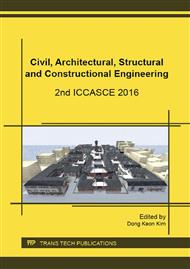p.184
p.190
p.196
p.202
p.208
p.214
p.219
p.227
p.234
A Feasibility Study of Engineered Cementitious Composites with Local Ingredients
Abstract:
Polyvinyl alcohol (PVA) fiber reinforced cementitious material (called PVA-ECC) has been intensively studied as a promising alternative to ordinary cement materials. While PVA-ECC has high stain capacity and ductility, its extreme high cost mainly caused by the high unit cost of used Japanese fiber has hindered its application in China. In order to reduce the cost of PVA-ECC, one type of inexpensive PVA fiber produced in China was used to develop a ductile ECC with deflection hardening and multiple cracking behaviors in this research. Compressive strength test, four-point bending test and uniaxial tension test were conducted to investigate the mechanical properties of the newly developed composites. The results show that ECC made with domestic ingredients exhibits large deformation and multiple cracking, revealing that it is feasible to produce low cost ECC material employing local PVA fibers.
Info:
Periodical:
Pages:
208-213
Citation:
Online since:
November 2016
Authors:
Price:
Сopyright:
© 2017 Trans Tech Publications Ltd. All Rights Reserved
Share:
Citation:


